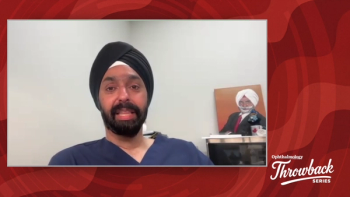
PRK found safer than LASIK for RK re-treatments
Conventional LASIK and wavefront-guided PRK produced similar visual results compared with conventional PRK when performed to enhance RK procedures. LASIK, however, was associated with substantially more complications, said John Cason, MD, who presented the findings of the RK Re-treatment Study.
San Diego-Conventional LASIK and wavefront-guided PRK produced similar visual results compared with conventional PRK when performed to enhance RK procedures. LASIK, however, was associated with substantially more complications, said John Cason, MD, who presented the findings of the RK Re-treatment Study.
The RK Re-treatment Study Group retrospectively analyzed RK re-treatment procedures (112 PRK, 109 LASIK) from six U.S. surgical centers that included 221 procedures over a 12-year period. All except three LASIK procedures were conventional and performed using a mechanical microkeratome; about two-thirds of the PRK procedures were conventional and one-third of the procedures were wavefront guided, explained Dr. Cason, assistant professor of the Uniformed Services University of the Health Sciences, Naval Medical Center San Diego.
Mitomycin C was used intraoperatively during all PRK procedures. The refractive errors were similar between the PRK and LASIK groups, with all refractive errors represented; slightly more patients with astigmatism were in the PRK group. The cases ranged from 1997 to 2010, he said.
Dr. Cason noted that the study-group procedures reflected changing trends in RK re-treatments during the course of the study. LASIK was gaining in popularity in 1997 and there were a resultant large number of conventional re-treatments through 2005. Wavefront-guided procedures then began to gain in popularity in the middle of the decade. With the use of mitomycin C and the subsequent reduction in haze postoperatively, the pendulum shifted from LASIK to PRK.
Analysis of the results showed that 3 to 6 months postoperatively there was a significant difference in the loss of best-corrected visual acuity (BCVA); conventional LASIK and wavefront-guided PRK had similar results that were superior to conventional PRK. Specifically, 26% of patients who underwent conventional PRK, 5% of patients who underwent wavefront-guided PRK, and 10% of patients who underwent LASIK lost one or more lines of BCVA. No patient lost more than two lines of BCVA, Dr. Cason said.
Regarding the uncorrected visual acuity (UCVA), about 40% of patients who underwent all types of enhancement procedures had UCVA of 20/20 or better, which was similar to previously published results. More than 80% of patients achieved 20/40 or better UCVA. The results following conventional LASIK were similar to those of wavefront-guided PRK, and both exceeded conventional PRK; the results with myopic and hyperopic treatments were similar, according to Dr. Cason.
When considering the entire cohort of patients, about 50% saw within 0.5 D of emmetropia and 80% to 85% saw within 1 D.
The complication rate was higher with conventional LASIK than with wavefront-guided PRK, despite similar visual outcomes.
“The LASIK group had a 12% rate of complications, and the wavefront-guided PRK group had 4%,” Dr. Cason said. “This included two patients with ectasia in the LASIK group who required penetrating keratoplasty. The postoperative haze that developed in the PRK group required that two eyes undergo phototherapeutic keratectomy; the patients achieved 20/20 and 20/25 vision.
“The visual outcomes with wavefront-guided PRK with mitomycin C were equivalent to conventional LASIK performed with a mechanical microkeratome,” he added. “The two procedures achieved better results compared with conventional PRK. More complications developed in the LASIK group that included two cases of ectasia. These findings were similar to previously published studies. We recommend that future prospective studies be performed to evaluate the observations of this study.”
Dr. Cason has no financial interest in the subject matter. The views expressed in this article are those of the author and do not necessarily reflect the official policy or position of the Department of the Navy, Department of Defense, nor the U.S. Government.
For more articles in this issue of Ophthalmology Times eReport,
Newsletter
Don’t miss out—get Ophthalmology Times updates on the latest clinical advancements and expert interviews, straight to your inbox.



















































.png)


